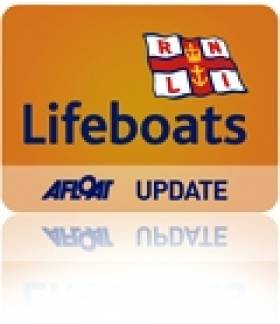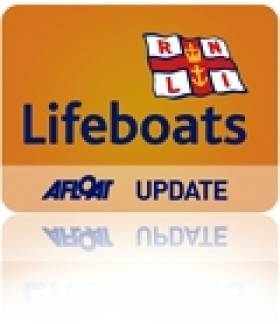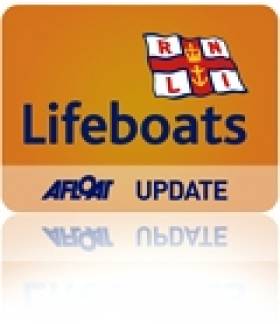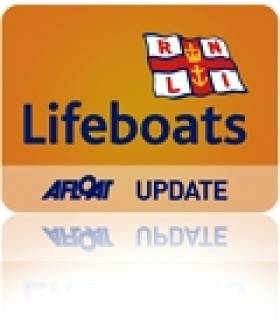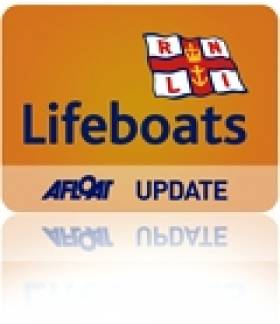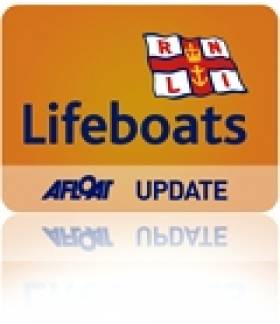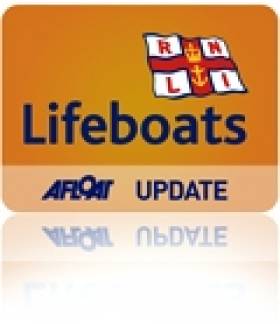Displaying items by tag: Lifeboats
'Safety Sunday' With Lifeboat Launches In Wicklow And Skerries
#RNLI - Wicklow RNLI went to the assistance of three fishermen whose 36ft fishing boat suffered engine failure near Wicklow Head yesterday afternoon (Sunday 24 November).
The alarm was raised after the crew were unable to start the engine and were concerned about the possibility of their boat being swept ashore.
The Wicklow RNLI all-weather lifeboat launched at 2.30pm under the command of coxswain Ciaran Doyle, followed a few minutes later by the inshore lifeboat.
The drifting fishing vessel was located 10 minutes later about half a mile east of Brides Head. Weather conditions at the time had the wind at a northerly Force 3, with a slight sea state and good visibility.
A towline was quickly established and the stricken vessel was towed back to Wicklow by the lifeboat before 3pm with no further incident.
Much earlier in the day, the Skerries RNLI volunteer crew were tasked to investigate reports of a person in the water in Balbriggan Harbour in the small hours of the morning.
The crew were paged at 12:30am and the lifeboat was launched shortly after with helms Joe May, Conor Walsh and David Knight and crew member Peter Kennedy on board.
There was a Force 3 to 4 northwesterly wind blowing at the time and the sea state was moderate.
The lifeboat proceeded directly to Balbriggan Harbour where it was quickly determined that the person had been taken from the water and was receiving first aid treatment by members of Dublin Fire Brigade and the HSE ambulance service.
The lifeboat then proceeded to carry out a thorough search of the harbour to ensure that there was nobody else in the water before returning to station.
Speaking afterwards, helm Joe May said: "Our volunteer crew are on call 24 hours a day, 365 days of the year. The pager can go off at any time but we are always ready to respond."
Book Charting History Of Arklow RNLI Launches This Friday
#RNLI - Olympic gold medallist and son of Arklow, Ronnie Delaney, will be on hand this Friday 22 November for the official launch of a new book that charts the history of the Wexford town's lifeboat station.
As previously reported on Afloat.ie, To the Banks & Beyond was written by local historian Jim Rees, who spent a number of years putting together the project that recounts the history of Arklow RNLI from 1826 to the present day in words and pictures.
A limited run of hardback editions has already sold out, but the paperback is still available priced at €15 (plus P&P) via Arklow RNLI Fundraising or the lifeboat station shop at 0402 32850 or [email protected].
Courtown Lifeboat Assists Stranded Angling Vessel
#RNLI - The Courtown RNLI lifeboat was launched yesterday afternoon (Sunday 17 November) to assist and tow a small 19ft angling boat.
The angling boat had suffered engine failure and required a tow to Courtown Harbour.
The lifeboat, with volunteer crew Glen Deacon, David Switzer and Áine Stafford, went to the assistance of the angling boat and towed it to safety without incident.
Dun Laoghaire Lifeboat Crewman Will Don Full Kit For Reindeer Run
#RNLI - Dun Laoghaire RNLI volunteer crewmember Damien Payne has vowed to complete the popular Reindeer Run charity event on the 5km course in his full RNLI crew kit.
Payne hopes to both fundraise for the lifesaving charity and to show people the kit that the money they raise can buy.
Originally from Cork but now works in Dublin with a healthcare company, Payne has been a volunteer at the busy Dun Laoghaire RNLI lifeboat station for two years.
The lifeboat kit he will be running in consists of the distinctive yellow oil skin jacket and dungarees with the red RNLI lifejacket that all crew must wear when they go to sea.
The only concession he's making is to leave the steel-capped yellow wellies at the starting line and to don a pair of trainers instead. An RNLI lifejacket costs €420 and the special yellow wellies cost €50.
Payne explained his reasons for taking part in the run wearing his lifeboat kit: “I want to wear the RNLI lifeboat crew kit to show people where the funds they raise are going and how vital our equipment is in the work we do.
"One of the first callouts I took part in was late one Friday afternoon to four children who were cut off on a sandbank by the incoming tide in Sandymount. They had no lifejackets and they couldn’t swim.
"When we recovered the children onto our lifeboat we learned it was the first time they had been on a boat and they had no knowledge of water safety."
Payne added: "The equipment and training we use in the RNLI is essential to the work we do and without we would not have been able to bring those children to safety."
As previously reported on Afloat.ie, year's Reindeer Runs are being held on Sunday 1 December at Marlay Park in Dublin and on Sunday 24 November at Fota House and Gardens in Carrigtwohill, Co Cork with a 5km and 10km walk or run, and a 1km Santa Saunter for younger participants.
Registration is now open and costs €10 for the saunter, €21 for the 5km and €23 for the 10km run or walk. There are also family and group rates available. All participants receive a limited edition RNLI Reindeer Run t-shirt and a pair of antlers.
Further information and registration details are available at rnli.org/reindeer or by emailing [email protected] for Dublin or [email protected] for Cork.
Clifden RNLI Names New Atlantic 85 Lifeboat
#RNLI - Clifden RNLI officially named its new Atlantic 85 lifeboat, Joyce King, at its station in the Connemara coastal town of Clifden in a special ceremony yesterday (Saturday 9 November).
John Coyle, chairman of the Irish council of the RNLI, accepted the lifeboat on behalf of the institution before handing her over into the care of Clifden Lifeboat Station.
Coyle paid tribute to the donor John Charles King, who had generously funded the lifeboat through a gift left in his will.
King - who hailed from Lincolnshire in England - funded the lifeboat, which has been in service in Clifden since June, in memory of his wife Joyce.
Jackie O’Grady, chair of the Clifden RNLI lifeboat management group and a former honorary secretary at the station, then officially named the lifeboat during the ceremony.
The new state-of-the-art Atlantic 85 lifeboat, at 8,4m in length and weighing 1.8 tonnes, was introduced into the RNLI fleet in 2005. Improvements on its predecessor include a faster top speed of 35 knots, radar, provision for a fourth crew member and more space for survivors.
Since the new lifeboat went into service in Clifden, it has had seven call-outs and 20 people have been brought to safety.
Clifden RNLI lifeboat operations manager John Brittain said the naming ceremony and service of dedication was a special occasion in the history of the lifeboat station, adding that the volunteer crew was grateful to King for his generous legacy.
He said the RNLI could not operate its lifeboats without the dedication of volunteer lifeboat crew.
"The 37 men and women currently on our crew in Clifden give 100% at all times. Their commitment and on-going attendance for training both here and at the lifeboat college means that they are highly proficient in the operation of their lifeboats.
"Further testament of the dedication of the crew is their knowledge that they may risk their own lives in the service of others. There is nothing greater that a person could offer and they deserve nothing less than the best lifeboat, equipment and training that money can buy."
Brittain went on to pay tribute to the vital support provided by the volunteers who support the crew.
"However, the lifeboat crew and I are only one part of this station. I must mention our operation team, supporters and fundraisers who volunteer their time and efforts and do so much for Clifden RNLI. These are people of all ages who give what time and money they can – thank you."
The RNLI established a lifeboat station in Clifden in early 1988 when a C-class lifeboat was put on service for one season’s evaluation. The following year Clifden RNLI became fully operational as a summer season only lifeboat station.
In 1992 part of a building used for housing the lifeboat was demolished and a new purpose-built building was constructed in order to provide adequate facilities for the lifeboat and crew. As well as providing an area for the C-class lifeboat and launching vehicle, it included a workshop and crew facilities.
In 1997, an Atlantic 21 lifeboat was placed on service and a new boathouse for the lifeboat and a tractor was completed in August 1998. A new Atlantic 75 B-class lifeboat was placed on service in 1999 and remained stationed until June when it was replaced by the Atlantic 85.
Fast, manoeuvrable and reliable, the B-class operates in rough weather conditions, capable in daylight up to force seven and at night, to force six winds. The new lifeboat, an Atlantic 85, is the latest version of the B-class.
A crowd of well-wishers turned up to see the lifeboat officially named with a bottle of champagne poured over the side of the boat before it launched at the end of the ceremony.
Clifden RNLI lifeboat crew member David Barry welcomed guests and opened proceedings while Lavinia Joyce from the Clifden RNLI fundraising branch delivered the vote of thanks. Father James Ronayne and Reverend Stan Evans lead the service of dedication.
Arklow Lifeboat Crew Comes To Aid Of 'Sammy The Seal'
#RNLI - Arklow RNLI’s volunteers were involved in an unusual rescue yesterday (5 November) at Arklow Harbour's boat slipway when they came to the aid of a seal pup.
Lifeboat crew were alerted to the marine mammal's plight by a member of the fishing community who had spotted the seal in an exhausted condition near Arklow lifeboat station.
On arriving at the scene, Arklow RNLI lifeboat volunteer press officer Mark Corcoran made contact with the Irish Whale & Dolphin Group and the Irish Seal Sanctuary to ascertain the best course of action to assist the seal pup. Also on scene was Tommy Heffernan from Avondale Vets.
Arklow RNLI lifeboat crew members including Scott Heaney and other members of the public assisted by keeping onlookers and curious dogs away from the distressed seal, who was determined to be tired and dehydrates following consultations with experts.
It was then decided that it would be best to remove the baby seal - named Sammy by the crew - to the safety of Avondale Vets and, once he was stabilised, to move the seal onward to the Irish Seal Sanctuary.
The pup is now being cared for by the Irish Seal Sanctuary and will enjoy a diet of fresh fish until it reaches a healthy weight and can be released back into the wild.
"It was an amazing experience to get so close to a seal," said Corcoran after the call-out. "They’re really fantastic creatures, and it’s not an everyday occurrence.
"Thanks to the teamwork demonstrated by the different groups involved, the story had a happy ending and I’m really pleased that we could help."
End Of An Era At Wicklow Lifeboat Station
#RNLI - It was the end of an era on Friday night 1 November as Wicklow RNLI held a retirement presentation to mark 46 years of service to Wicklow lifeboats by one of its greatest servants, Kit Dunne.
Dunne first became involved with the RNLI way back in 1966. Since then he has served with several different coxswains either as crew or, after taking up the post in 1993, as a deputy launching authority.
Well known in Wicklow Harbour as a pilot, Dunne even came to the aid of the pilot boat when he was aboard the lifeboat JW Archer as a crewman back in 1972.
The 18ft boat had engine failure and with a falling tide was in danger of drifting out to sea when the lifeboat launched to their aid.
Over a period of 27 years, Kit Dunne served the RNLI with distinction. In 1993 he retired from active service but hon secretary Kevin Desmond decided that his common sense experience and loyalty should not be wasted and he was invited to become a deputy launching authority, a position he held until his retirement at the end of last year.
At the retirement presentation, divisional operations manager Owen Medland lauded Dunne's service and dedication over so many years and presented him with a framed certificate of service.
Wicklow RNLI chairman and former coxswain Gerard Haughton also spoke very highly of his time serving with Dunne.
At the very special evening surrounded by family, friends and former colleagues, Dunne was presented with a framed memento of the two lifeboats he had served on, the JW Archer and the Annie Blaker, by Wicklow lifeboat operations manager Des Davitt, who praised him for his outstanding service to his community and the RNLI. He also thanked him for his help and counsel over the last 10 years.
Most important to Dunne was the painting presented to him by his peers. The beautiful artwork, by local artist Pat Dover, was presented by coxswain Nicky Keogh, second coxswain Ciaran Doyle and station mechanic Brendan Copeland on behalf of the crew.
They spoke of the knowledge and experience Dunne has passed down to the new crewmembers over many years. Meanwhile, his son, Kit Jr, told of his pride in his father, who not only served his community but is also a great father and family man.
Kit Dunne thanked all present and told of his great pride in serving such a great organisation as the RNLI. He left the stage to a standing ovation.
In 2005 Dunne was awarded the silver statuette by the RNLI for his service to the institution, but it was clear on the night that he needed no awards or presentations, as his greatest reward was to have served with so many selfless and courageous people over so many years.
Howth, Kilrush Lifeboats Launch In Gale Force Winds At Weekend
#RNLI - Howth RNLI has brought six people to safety on Saturday evening (2 November) after their 37ft yacht got into difficulty north of Dublin Bay.
The volunteer crew was requested to launch their all-weather lifeboat by the Irish Coast Guard shortly after 6pm following a report that a 37ft yacht was unable to safely enter the harbour from one mile east of Howth Harbour.
The lifeboat, under coxswain Robert Duffy and with six crew members onboard, launched in five minutes into gale force winds and made its way to the scene.
Weather conditions were difficult, with winds blowing Force 8 to 9 at the time and gusting to 45 knots.
The lifeboat located the yacht in a calm, sheltered bay off Howth Head. A lifeboat crew member was then transferred to the disabled boat which had encountered a mechanical problem. A tow line was then established and the lifeboat brought the vessel to safety at Howth at 7pm.
Speaking following the call-out, Duffy said: "This was a challenging call-out for our volunteer crew tonight given the gusty weather conditions and the darkness.
"Thankfully we were on scene quickly and using our training, we were able to assist the six crew members on board the yacht and bring them safely to shore."
Elsewhere, Kilrush RNLI brought a yacht which was dragging its mooring off Hogg Island to safety on Saturday morning.
The volunteer crew was requested to launch their inshore lifeboat at 9.40am, and within minutes they had sighted the vessel, which was located a short distance from Cappa Pier.
A crewmember was put aboard the vessel to start the engine and bring it to another secured mooring. In the meantime, the crew put a line on the strayed mooring line and towed it out of the way from the main shipping line.
Winds were extremely strong gusting up to Force 8, and it was decided in the interest of safety that the yacht be brought into Kilrush Creek Marina.
Kilrush RNLI lifeboat operations manager John Lamb praised the crew who he said put their skills and training to good work in what was challenging weather conditions.
"When volunteer crew members put in the time for training, their efforts pay off on call-outs such as this one this morning and thankfully we were able to bring this vessel to safety," he said.
Clifden RNLI Crewman Shares Lifesaving Skills On Danish Lifeboat
#RNLI - Clifden RNLI volunteer crewmember James 'Digger' Mullen was selected from thousands of RNLI volunteers to represent the charity last month on a European Lifeboat Crew Exchange in Denmark.
Lifeboat crew from seven European countries were invited on a week-long programme designed to improve maritime search and rescue (SAR) responses and help to prevent loss of life in Europe’s waters.
The initiative is run by the International Maritime Rescue Federation (IMRF) and comprises simulated search and rescue exercises as well as training modules, which were organised by the Danish Rescue Coast Service.
During an exhaustive week, Mullen had an opportunity to work with Danish lifeboat crew from three lifeboat stations and took part in various challenging scenarios with the Danish navy and the rescue helicopter crews.
Mullen, from the Clifden lifeboat in Co Galway, worked alongside lifeboat crew from Holland, Norway, Finland, Sweden, Iceland and Germany from a base in Hirtshals, a town on the north coast of Denmark. The area the local lifeboat crew operated in was completely different to Clifden with no breakers or islands off the coastline.
The group went to sea on Hirtshals lifeboat station’s two rescue boats: a 23m all-weather boat and a 9m fast response boat (FRB) that reaches speeds of up to 30 knots. The group travelled down the coast 40 miles to meet up with Thorup Strand lifeboat station and their 9m jet rescue boat Hurricane, which reaches speeds of 40 knots.
The team carried out a medical evacuation with a navy patrol boat and refueled the lifeboat at sea from the navy ship, while both vessels were travelling at 8 knots. The crew also took part in a joint lifeboat helicopter exercise; a common occurrence for lifeboat crew on Irish waters.
The week was full of simulated rescues and boat handling, with all the lifeboat crewmembers swapping their knowledge and feedback on what they found worked in different types of emergency scenarios in their own areas.
The final two days of the exercise were spent with the Danish navy and the team attended naval training school. They were taught how to board a life raft in big seas, how to abandon ship from a six metre bridge, and how to recover unconscious casualties into a liferaft.
At the end of the training there was a mass exercise. The pool was darkened, filled with smoke, wind, rain, lighting and thunder, and they evacuated their ship to find an unconscious casualty and recover them on to a nearby liferaft.
The final exercise was held in the navy fire fighting/damage control training centre. The group were taken onto a simulated navy ship and had to stem a growing ingress of water which was flowing in through numerous breeches and ultimately save the ship from sinking. This was to be done with timber, rubber mats, wedges, buckets, ropes, hand saws and hammers. In the freezing water which was pouring into the ship, the team all worked together to try and stem the flow and save the ship.
Commenting on the week, Mullen said: “I am extremely grateful that this exchange programme has been made possible through EU funding on the Lifelong Learning Programme. Our group of lifeboat crew from across Europe shared experiences with each other and listened to everyone’s feedback.
"Though we all spoke difference languages, we generally all do what we do the very same way, just using different boats with different equipment. Saving lives at sea is the same in every language."
RNLI divisional operations manager Owen Medland added: “We were delighted to have an RNLI volunteer crewmember on this exchange. The experience James has had in his role operating lifeboats off the west coast of Ireland is invaluable and we were keen to share this knowledge with a wider search and rescue community.
"There are always things we can learn from each other and it promotes a wider understanding of how saving lives at sea has evolved and continues to evolve due to improved equipment and continuing training.”
Major Search For Woman In Galway Docks Is False Alarm
#RNLI - Galway RNLI joined a major search for a woman believed to have entered the water at Galway Docks in the early hours of yesterday morning (Friday 1 November) that turned out to be a false alarm.
The Irish Coast Guard received a report about the missing woman shortly before 2am and immediately sought the assistance of Galway RNLI volunteer crew who launched the lifeboat from the nearby station within minutes.
Galway Fire Brigade and Mill Street Gardai searched the perimeter of the docks, including the boats and marina, while the Galway lifeboat searched the rest of the Docks.
They were joined in their efforts by coastguard rescue helicopter from about 3am but nothing was found.
After some investigation, it was discovered that the person who was reported missing was in fact safe and sound at another location.
Galway RNLI lifeboat operations manager Mike Swan said the search operation was eventually stood down at about 4am.
"While this incident proved to be a false alarm, Galway RNLI is always willing and ready to respond to anyone who is thought to be in danger in the water," said Swan.
"Each time the lifeboat is called out it costs the station up to €4,000. All of our lifeboat crew and land crew are volunteers and we rely solely on fundraising and the generosity of the public to keep the station and service running."



























